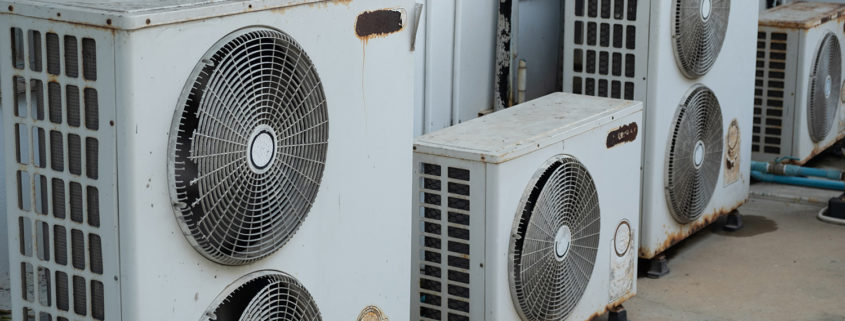How long will your facility’s air conditioning and heating system last? There are so many components involved that it’s hard to make a single estimate. On average, business owners can expect the life expectancy of commercial HVAC systems to be anywhere from 10 to 20 years before they need major repairs.
However, there’s always a risk that faulty parts and minor issues will shorten the life of expensive components. If you want to get the most from your HVAC equipment, you need to keep up with regular maintenance, and also perform preventative maintenance. By taking care of small problems, your HVAC units will last longer and deliver lower operating costs during the building’s life.
What Makes Commercial Systems Different from Residential Systems?
Commercial buildings have more climate spaces to manage. Your home has a single thermostat that turns the heater and air conditioner on and off as needed. An office building has a thermostat in each client space, while a factory may have several areas that require temperature controls for different processes. Some buildings have unique demands from their occupants. A museum needs several climate zones with tightly controlled temperature and humidity to preserve artifacts. A medical facility needs to stop the spread of pathogens, so the HVAC system may use added filters and UV light-based germicidal systems.
As the size of a building increases, so does the scale of air quality issues. Fresh air must be introduced to lower carbon dioxide concentrations and remove airborne chemicals that can leave behind odors.
There are two ways to control these systems. Smaller buildings use individual thermostats to request heating or cooling from the HVAC system. Large buildings use Direct Digital Controls (DDCs) to centralize air management across the entire building. This balances air demand across the entire system, while making adjustments to control indoor air quality.
While HVAC components have the same jobs in both residential and commercial systems, they use different types of construction. Residential systems use split components. While your heater is inside your home, your air conditioner condenser sits outside. A commercial system puts most of its components on the roof, and each system is self-contained. This provides easier access for maintenance, but it also means the roof has to be maintained to support heavy equipment due to the sheer size of the units.
This also allows for expandability that you can’t get with a residential system. If more heating or air conditioning capacity is needed, either a larger commercial HVAC unit can be swapped in, or a whole new unit can be added to the system.
The sheer size of commercial HVAC equipment adds complexity. For example, your home air conditioner has a small drain for water, but a commercial system needs a series of pipes to manage collected moisture.
How Long Should the Components in My HVAC System Last?
These are the average lifespans of major HVAC components, according to the ASHRAE Service Life and Maintenance Cost Database.
Heat pump: Up to 15 years
Air conditioner: 15-20 years
Heater: 15-20 years
Boiler: 20-30 years
Roof tank: Up to 15 years
Heat exchanger: 15 to 20 years
This is just a small fraction of the components in your building’s HVAC system. What about fans? The ASHRAE database lists four designs, each with their own expected service life. Then there are valves, pipes, ductwork and many other parts, each with their own maintenance and service requirements.
What Wears Out My System?
Quality of Installation
A poor quality installation can lead to air and water leaks, as well as inefficient distribution of air. A poorly-planned installation may use undersized commercial heating and cooling units that have to run continually. This leads to premature failure.
Extreme climates
The longer your air conditioner or heater has to run, the sooner it will wear out. Winters and summers are harsh here, so these components work harder than they would in other parts of the country.
Chemicals
Air pollution leads to corrosion. Copper components, used in the coils of air conditioning units, are particularly susceptible. This pollution comes from a variety of sources, including factory chemicals, cleaning products and off gassing construction materials.
Failing components
The failure of any component can cause a knock on effect, wearing out the rest of your system. Clogged filters add strain to fan motors. Bad thermostats keep the system running for too long. Holes and breaks in the duct work can disrupt airflow, prevent air from reaching rooms, and can let outside air in, requiring more power to control temperatures.
Save Money on Fuel and Electricity
Most of your operating costs for your HVAC system aren’t for the system itself, it’s for the fuel it uses. Commercial systems are far more complex than residential systems, because they’re built to maximize the heating and cooling potential of every bit of gas and electricity that enters the system. Equipment becomes less efficient as it ages, while technological improvements increase the efficiency of new systems. At some point, it makes more sense to replace your equipment instead of continuing to fix it as repair costs rise due to continued breakdowns. That said, if you keep up with proper maintenance, your equipment will age slower and maintain energy efficiency longer. This can reap huge savings on utility costs.
When You Need Help with Your Commercial HVAC System, Call the Experts
Tema Roofing Services does more than just build and repair commercial roofing. We also offer repair and routine maintenance services for commercial and industrial HVAC systems. If you’re looking for quality HVAC service, contact us to get a free quote. We can help you with HVAC repairs, extending the lifespan of your HVAC system, and we will work with you to set up a maintenance plan for your buildings.





